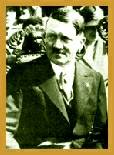|
PinkMonkey Online Study Guide-World History
13.3 The Rise and Fall of Dictatorship in Germany
There were several factors that contributed to the growth of Nazi dictatorship in Germany after 1930.
After World War I, Germany was filled with a sense of discontent, hatred and revenge, as the Treaty of Versailles crippled her physically, exhausted her economically and weakened her emotionally.
The Treaty of Versailles was not enforced strictly by the Allied Powers like Britain, U.S.A. and France.
Currency inflation created serious problems in the country. Before the war, the value of a dollar was 4.2 German marks. By November 1923, it became absolutely worthless at 2.52 trillion to one dollar. To remedy this problem, the government issued a new currency at the old rate, namely 4.2 marks to one dollar. The government fixed the ratio at one new mark to one trillion old marks. Thus the life savings, in the form of bank deposits, insurance, provident funds, pensions and cash, were all wiped out.
The result of the currency inflation was that all industries, factories, workshops and mills were paralyzed. There was widespread unemployment, starvation, and desperation. The introduction of the Dawes Plan in 1924 was followed by an unprecedented prosperity in Germany, upto 1929. However, when the world economic depression came in 1929-1930, Germany faced economic chaos.
After World War I, the atmosphere in Germany was filled with militant nationalism; this was the result of feelings of German superiority and of the utter national humiliation caused by the Paris Peace Conference of 1919. The Germans had no love for democratic institutions. They preferred prestige and glory to liberty and freedom.
After World War I, communist ideas were spreading throughout Germany. During the economic depression of 1929-1930, millions of jobless workers flocked towards the Communist Party. The middle classes therefore looked forward to the Nazis, to save their country, from a communist revolution.
Finally, the magnetic personality of Adolf Hitler was greatly responsible for the growth of the Nazi dictatorship in Germany. Hitler was chiefly responsible for making his fellow countrymen burn in the fire of revenge, for the national humiliation they had suffered.

Exhibit 13.2
Adolf Hitler
Adolf Hitler, an Austrian by birth, joined the German army during World War I. He won an Iron Cross for his bravery. In February 1925, he rebuilt and revitalized his political party, the Nazi party. Its strength increased gradually. In 1932, Hitler acquired German citizenship.
Fresh elections to the Reichstag (German Parliament) took place on March 5, 1933, in which 44% of the total seats were won by the Nazi Party. Thus Hitler formed a coalition government with the nationalists who won 8% of the total seats.

Exhibit 13.3
Hitler rounded up the Jews in ghettos
After becoming chancellor, Adolf Hitler crushed all opposition and began a campaign of repression against Jews and Communists. On June 30, 1934 he massacred thousands of socialists for treason, for which the day came to be known as ’Bloody Saturday.’
He centralized all the powers of the central and local governments, coordinated all the labor and youth organizations and controlled all the aspects of national life, including the Press, educational institutions, the stage and the cinema.
When President Hindenburg died on August 2, 1934, he was succeeded by Hitler.
The Nazi Party adopted three goals in its foreign policy:
Union of all the people of the German race by the right of self-determination, in one
great Germany The cancellation of the Peace Treaties of Versailles and St. Germain and The acquisitions of further territory for the support of the people
Hitler then took a series of measures to repudiate the Treaty of Versailles. On October 14, 1933, Germany gave notice of withdrawal from the League of Nations and the Disarmament Conference. On March 19, 1935, Germany violated Part V of the Treaty of Versailles by re-introducing military conscription. On March 7, 1936, Hitler dispatched troops to remilitarize the Rhineland.
To expand German territory and power, Hitler followed a policy of naked aggression. Germany entered into a pact with Japan against Russia. It was known as the Anti-Comintern Pact and was signed in November 1937.
With the help of Italy, Hitler annexed Austria on March 11, 1938. On March 15, 1939, Hitler invaded and annexed Czechoslovakia. Germany then signed the Non-aggression Pact with the Soviets, on August 23, 1939. Hitler launched an armed attack on Poland, on September 1, 1939. This was followed by the declaration of war upon Germany by Britain and France on September 3, 1939.
This initiated World War II (1939-1945). However, the Germans surrendered on May 7, 1945 and Hitler committed suicide. This brought Nazi dictatorship in Germany to an end.
[next page]
|